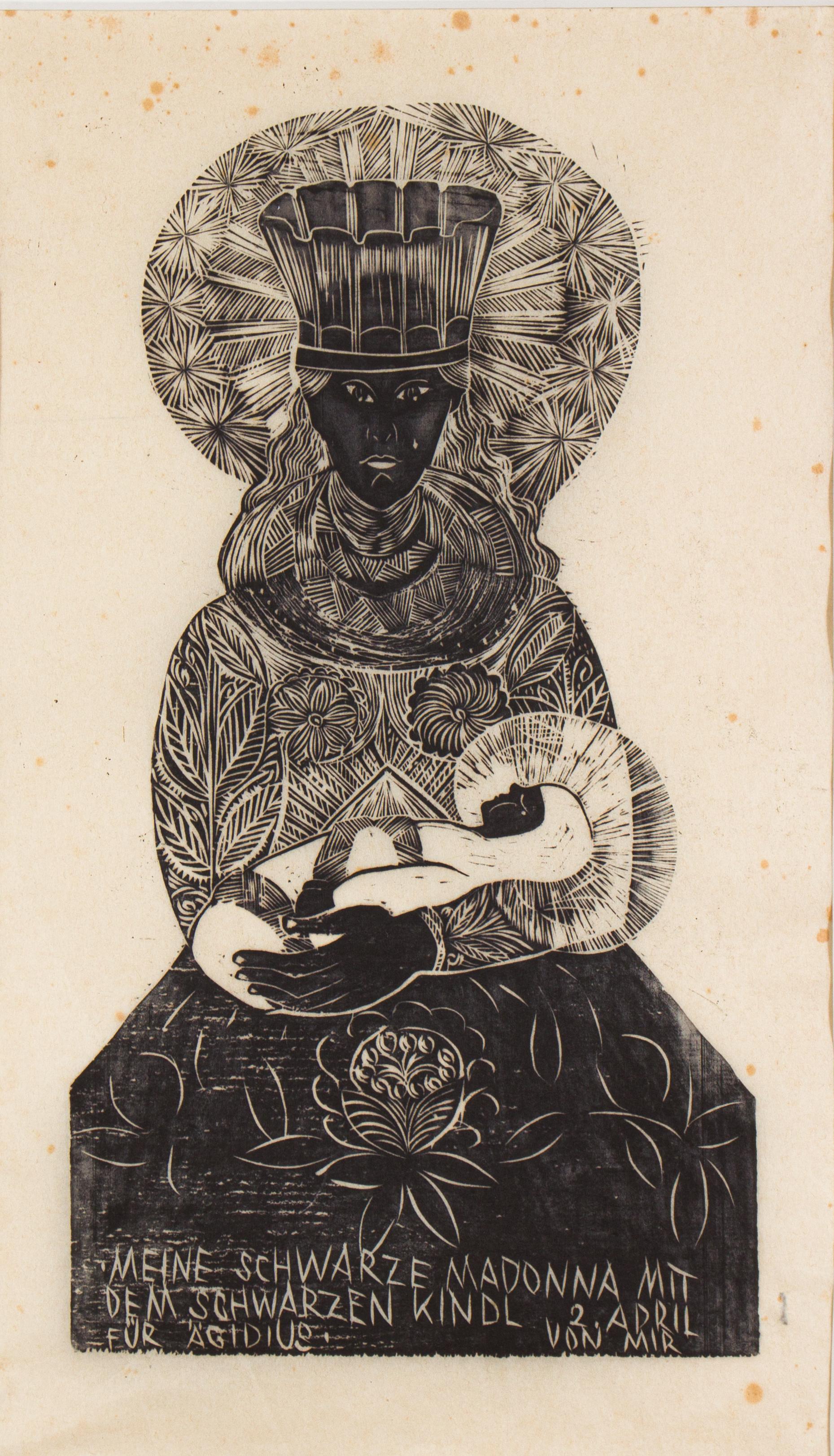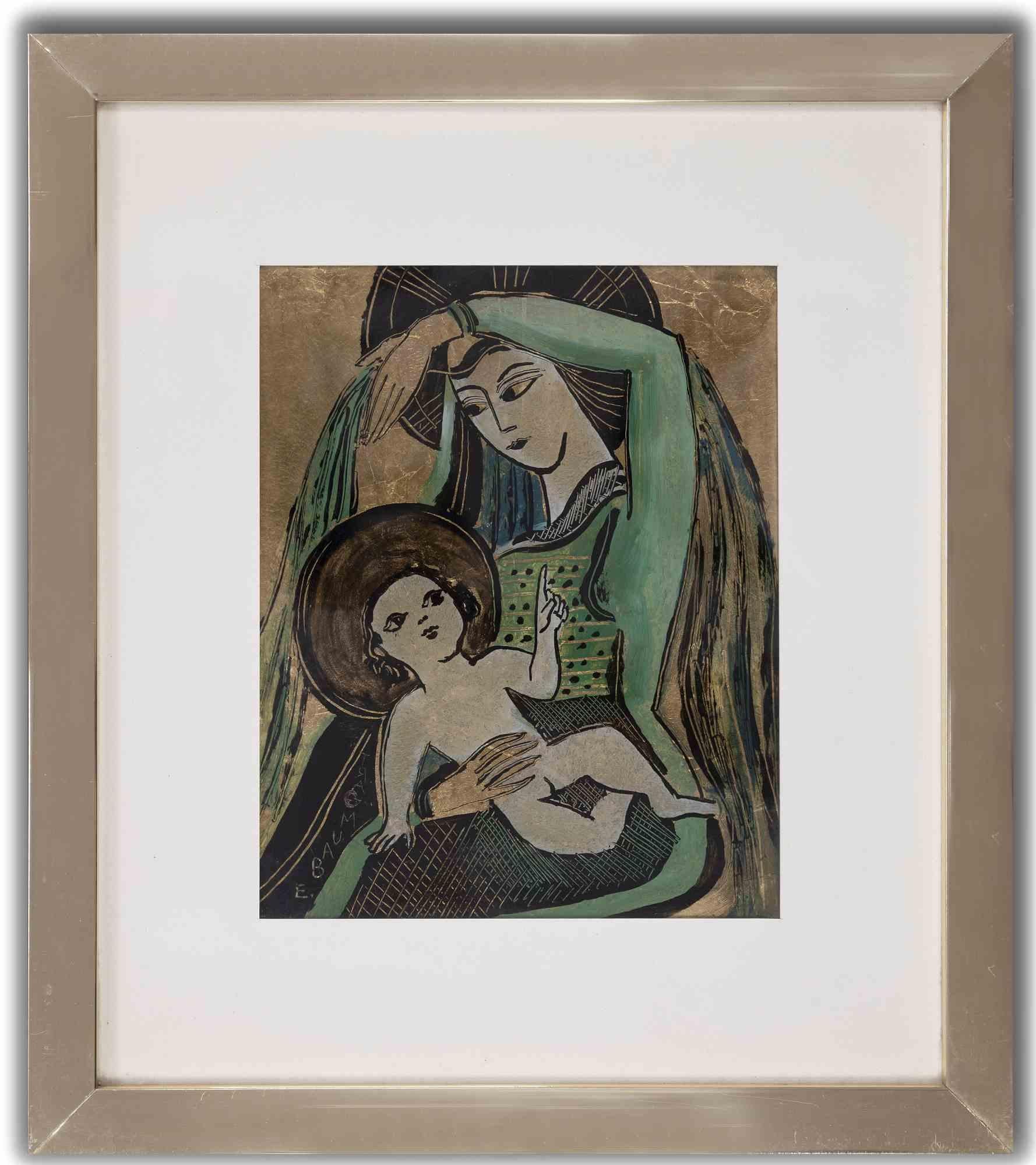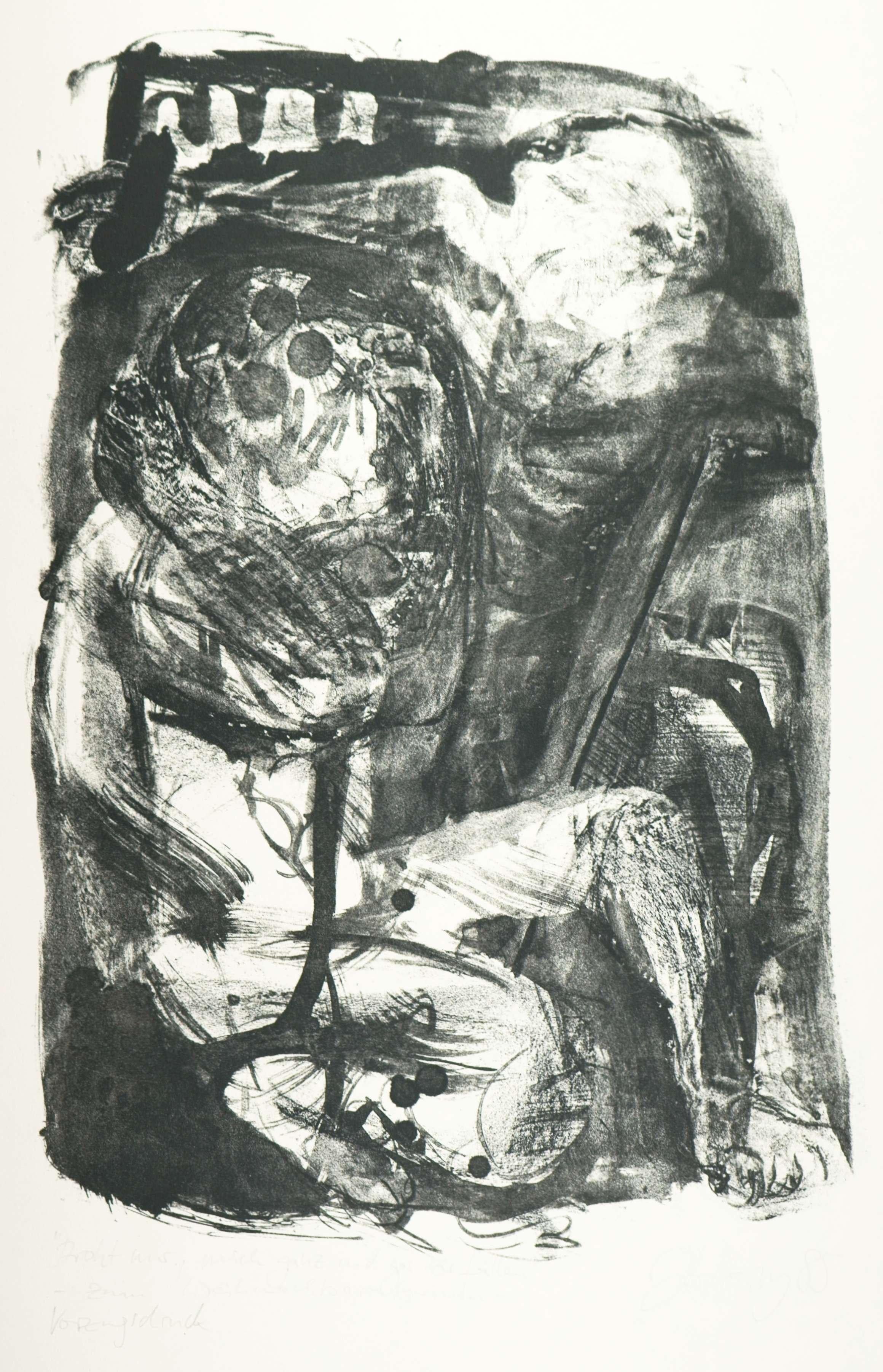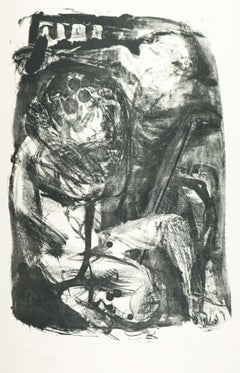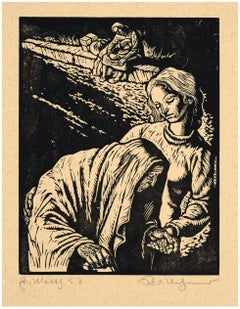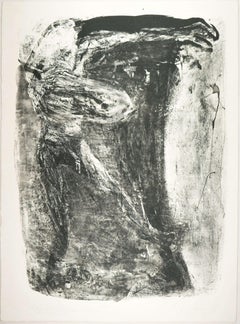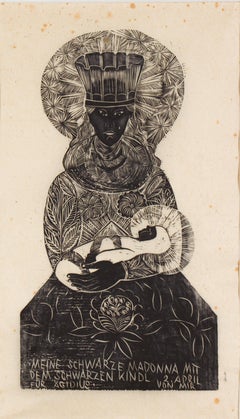Items Similar to Adoration of the Magi / - The Rider of the Sun -
Want more images or videos?
Request additional images or videos from the seller
1 of 7
Walter HelbigAdoration of the Magi / - The Rider of the Sun -1918
1918
$780.69
£578.82
€650
CA$1,072.49
A$1,170.80
CHF 616.44
MX$14,024.81
NOK 7,884.04
SEK 7,198.26
DKK 4,952.76
About the Item
Walter Helbig (1878 Falkenstein - 1968 Ascona), Adoration of the Magi, 1918. Hand-colored linocut, 30 cm x 22.5 cm (depiction), 50 cm x 35 cm (sheet size), signed “W.[alter] Helbig” in pencil lower right, inscribed “Adoration of the Magi” lower left and dated “1918”. Below this a handwritten dedication “with heartfelt Christmas greetings”.
- Paper somewhat darkened and with slight creases, thumbtack holes in the corners
- The Rider of the Sun -
The 'apocalypse' of World War I brought about a return to sacred art. Walter Helbig belonged to the circle of the 'Brücke' and the 'Blauer Reiter'. With his reinterpretation of religious themes in an expressionist formal language, Helbig shaped an avant-garde neo-sacred art. This is symbolically expressed in the silhouette of the rider against the sun-like yellow background. It refers to the awakening initiated by the Blue Riding, which is now linked back to the sacred.
The rider and horse "look" at Mary and the Christ Child, who occupy the entire field. Opposite them are the three kings, the eldest of whom kneels before Christ and offers him a gold-filled casket. The expressionist lines give rise to a tower that rises into the "sun", so that the gift has become a Gothic church, expressing the hope that the fallen world will be resurrected in the name of Christ. This dimension of meaning is emphasized by the magical effect of the color scheme.
About the artist
In 1895, Walter Helbig began studying at the Dresden Academy of Art, where he became friends with the future Brücke artist Otto Müller, with whom he lived in Dresden from 1903 to 1905. While studying in Italy from 1897 to 1899, he met Arnold Böcklin and Adolf von Hildebrand. After completing his studies, he first worked for Otto Gussmann, painting churches. From 1905 to 1909 he worked as a freelance painter in Hamburg. In 1909, through the mediation of Otto Müller, Helbig made the acquaintance of artists from the 'Brücke'. In 1910 he exhibited at the founding exhibition of the Berlin 'Neue Sezession'. In the same year, he moved to Switzerland, where, together with Hans Arp and Oscar Lüthy, he founded the 'Moderne Bund' in Weggis, to which Cuno Amiet and Giovanni Giacometti also belonged. At the second exhibition of the 'Moderne Bund' in Zurich in 1911, Henri Matisse and Robert Delaunay were represented alongside artists from the 'Blauer Reiter'. In 1913, Helbig traveled to Paris with Arp and Lüthy. After the dissolution of the 'Moderne Bund', Helbig was represented at the first Dada exhibition in Zurich in 1914. In 1919, he joined the Berlin 'Novembergruppe'. After the devastation of World War I, Helbig turned increasingly to religious themes in his work. In 1924, like many other artists of his time, he moved to Ascona for financial reasons, where he became a naturalized citizen in 1938. There he founded the artists' association "The Great Bear", to which Marianne von Werefkin also belonged. The group organized annual exhibitions from 1924 to 1940. Helbig also maintained a studio in Berlin until 1933, where he painted portraits of Tilla Durieux, among others. When the Nazis came to power, many of his works were removed from museums as "degenerate art. Helbig's first major solo exhibition took place in Zurich in 1948, and after the Second World War he opened up to current trends in art.
GERMAN VERSION
Walter Helbig (1878 Falkenstein - 1968 Ascona), Anbetung der Könige, 1918. Handkolorierter Linolschnitt, 30 cm x 22,5 cm (Darstellung), 50 cm x 35 cm (Blattgröße), unten rechts in Blei mit „W.[alter] Helbig“ signiert, unten links als „Anbetung der Könige“ bezeichnet und auf „1918“ datiert. Darunter eine eigenhändige Widmung „mit herzlichen Weihnachtsgrüßen“.
- Papier etwas nachgedunkelt und mit leichteren Knickspuren, an den Ecken Reißzweckenlöcher
- Der Sonnenreiter -
Durch die ‚Apokalypse‘ des Ersten Weltkrieges setzte eine Wiederbesinnung auf sakrale Kunst ein. Walter Helbig gehörte zum Umkreis der ‚Brücke‘ und des ‚Blauen Reiters‘. Mit seiner Neuauslegung religiöser Themen in expressionistischer Formensprache prägte Helbig die avantgardistische neo-sakrale Kunst. Symbolisch kommt dies in der Reitersilhouette vor dem sonnenartigen gelben Fond zum Ausdruck. Sie bezieht sich auf den vom ‚Blauen Reiten‘ initiierten Aufbruch, der nun sakral rückgebunden wird.
Reiter und Pferd ‚blicken‘ auf Maria und das Christuskind, die das gesamte Bildfeld durchmessen. Ihnen gegenüber sich die drei Könige situiert, deren ältester vor Christus kniet und ihm eine goldgefüllte Schatulle darbietet. Durch die expressionischen Lineaturen entwächst ihr ein in die ‚Sonne‘ hineinreichender Turm, so dass die Gabe zur gotischen Kirche geworden ist, was der Hoffnung Ausdruck verleiht, die untergegangenen Welt im Namen Christi wiederauferstehen zu lassen. Diese Bedeutungsdimension wird von der wie magisch wirkenden Farbgebung unterstrichen.
zum Künstler
1895 nahm Walter Helbig das Studium an der Dresdner Kunstakademie auf, wo er sich mit dem späteren Brücke-Künstler Otto Müller anfreundete, mit dem er von 1903 bis 1905 in Dresden zusammenwohnte. Während seines von 1897 bis 1899 währenden Studienaufenthalts in Italien lernte er Arnold Böcklin und Adolf von Hildebrand kennen. Nach dem Abschluss des Studiums war er zunächst für Otto Gussmann bei Kirchenausmalungen tätig. Von 1905 bis 1909 hielt er sich dann als freier Maler in Hamburg auf. Durch die Vermittlung Otto Müllers machte Helbig 1909 Bekanntschaft mit Künstlern der ‚Brücke‘. 1910 stellte er auf der Gründungsausstellung der Berliner ‚Neuen Secession‘ aus. Im selben Jahr übersiedelte er in die Schweiz, wo er in Weggis zusammen mit Hans Arp und Oscar Lüthy Mitbegründer des ‚Modernen Bundes‘ wurde, dem auch Cuno Amiet und Giovanni Giacometti angehörten. Auf der zweiten Ausstellung des ‚Modernen Bundes‘, 1911 in Zürich, waren neben Künstlern des ‚Blauen Reiters‘ auch Henri Matisse und Robert Delaunay vertreten. 1913 reiste Helbig zusammen mit Arp und Lüthy nach Paris. Nach der Auflösung des ‚Modernen Bundes‘ war Helbig 1914 auf der ersten Dada-Ausstellung in Zürich vertreten. 1919 schloss er sich der Berliner ‚Novembergruppe‘ an. Nach dem einschneidenden Ersten Weltkrieg widmete sich Helbig in seinem Schaffen zusehends religiösen Themen. 1924 zog er wie viele andere Künstler seiner Zeit aus finanziellen Gründen nach Ascona, wo er 1938 eingebürgert wurde. Dort gründete er die Künstlervereinigung ‚Der Große Bär‘, zu der auch Marianne von Werefkin gehörte. Die Gruppe veranstaltete von 1924 bis 1940 Jahresausstellungen. Bis 1933 hatte Helbig zudem ein Atelier in Berlin unterhalten, in dem er unteren anderen Tilla Durieux porträtierte. Mit der Machtergreifung der Nationalsozialisten wurden zahlreiche seiner Werke als ‚Entartete Kunst‘ aus Museen entfernt. 1948 fand in Zürich Helbigs erste große Einzelausstellung statt, der sich nach dem Zweiten Weltkrieg den aktuellen Kunstströmungen öffnete.
- Creator:Walter Helbig (1878 - 1968, German)
- Creation Year:1918
- Dimensions:Height: 19.69 in (50 cm)Width: 13.78 in (35 cm)Depth: 0.4 in (1 cm)
- Medium:
- Movement & Style:
- Period:
- Condition:
- Gallery Location:Berlin, DE
- Reference Number:1stDibs: LU2438216118192
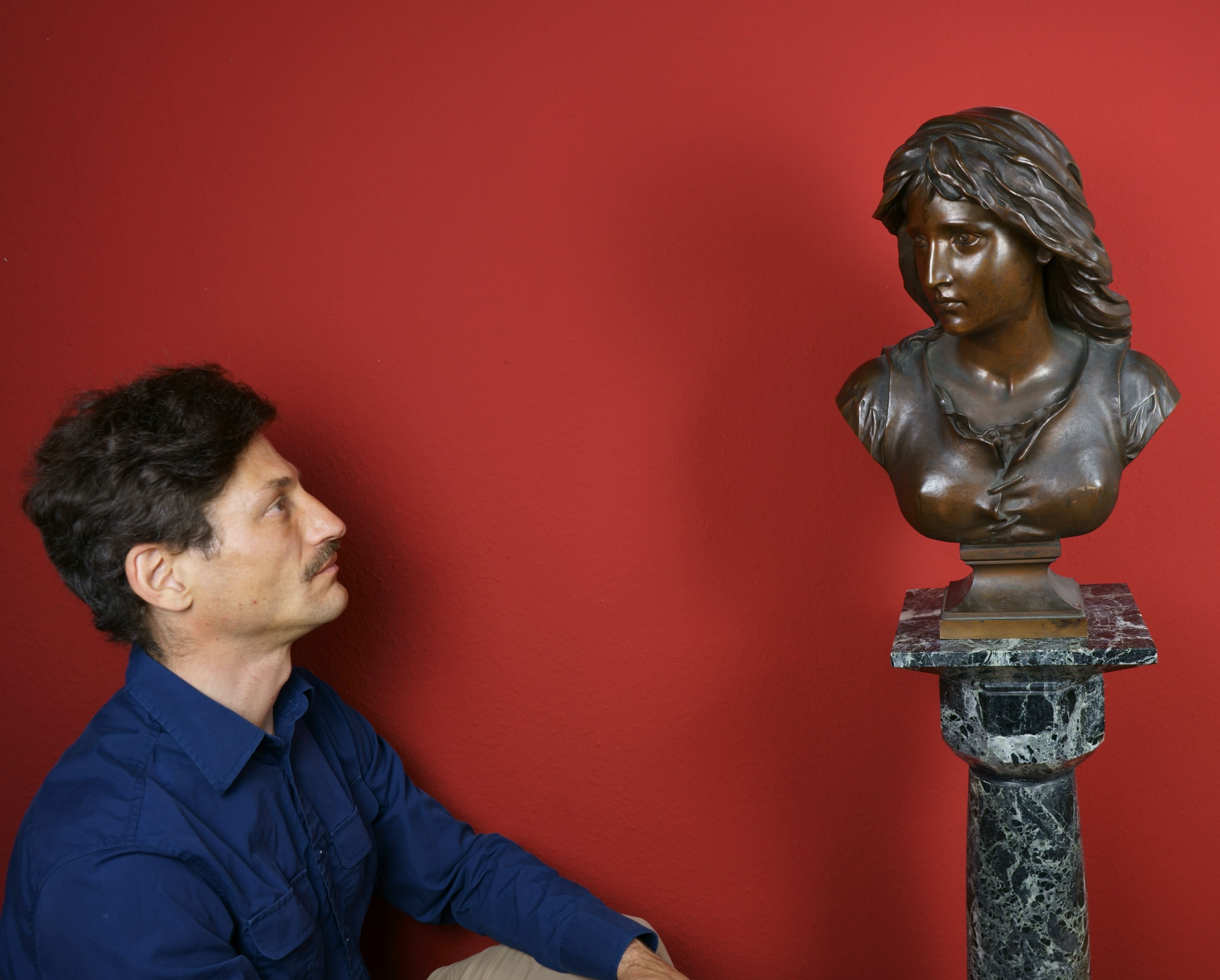
About the Seller
5.0
Vetted Professional Seller
Every seller passes strict standards for authenticity and reliability
Established in 2014
1stDibs seller since 2023
23 sales on 1stDibs
- ShippingRetrieving quote...Shipping from: Berlin, Germany
- Return Policy
More From This Seller
View AllThreatening to defeat me once and for all / - A Christmas Pietà -
Located in Berlin, DE
Johannes Heisig (*1953 Leipzig), "Threatening to defeat me once and for all" - To the Christmas Oratorio by Johann Sebastian Bach. Lithograph on strong yellowish laid paper with wate...
Category
1980s Abstract Expressionist Figurative Prints
Materials
Lithograph
The Prophet / - The Burden of the Prophet -
Located in Berlin, DE
Wilhelm Gross (1883 Schlawe - 1974 Oranienburg-Eden), The Prophet, c. 1955. Woodcut on thin laid paper, 43 cm x 23 cm (depiction), 61 cm x 43 cm (sheet size), signed “Dr. Wilh.[elm] Gross” in pencil lower right, inscribed “Orig.[inal] Holzschnitt (Handabdruck)” lower left and inscribed “Aus der ”Ecce homo“ Folge” in the center.
- The wide margin with traces of pressing due to the impression, the sitter's left foot with a small purple stain, otherwise in vibrant condition.
- The Burden of the Prophet -
The large-format woodcut shows a prophet figure that takes up almost the entire height of the sheet. However, instead of seeing something in the distance that is still hidden from our eyes - as is usual in depictions of prophets - the figure has raised his hands in a defensive gesture, as if the prophet is trying to ward off what he has seen. At the same time, however, the position of the arms is an acceptance of the inevitable, which only those who recognize what is to come will have to bear for the time being, which is why the figure in the painting - despite its size - appears almost solitary, alone and exposed to the burden of suffering.
In a manner reminiscent of the folds of medieval wooden sculptures...
Category
1950s Realist Figurative Prints
Materials
Paper
Blessed are the merciful / - The support of care -
Located in Berlin, DE
Nehmer, Rudolf (1912-1983), Blessed are the merciful, 1948
Rudolf Nehmer (1912 Bobersberg - 1983 Dresden), Blessed are the merciful, 1948. Woodcut on yellowish wove paper, 18.8 cm x ...
Category
1940s Realist Figurative Prints
Materials
Woodcut
My treasure, my sanctuary / - A Tortured Treasure -
Located in Berlin, DE
Johannes Heisig (*1953 Leipzig), "My treasure, my sanctuary" - To the Christmas Oratorio by Johann Sebastian Bach. Lithograph on strong yellowish laid paper with watermark, 53 x 39.5...
Category
1980s Abstract Expressionist Figurative Prints
Materials
Lithograph
The Mother / - Violated Motherhood -
By Georg Tappert
Located in Berlin, DE
Georg Tappert (1880 Berlin - 1957 Berlin), The Mother, 1918 (1964). Estate print from 1964. Linocut on Japan, 31.5 cm x 20 cm (image), 44.5 cm x 28 cm (sheet size), marked lower left...
Category
1910s Expressionist Figurative Prints
Materials
Paper
The Zero Hour / - After the End of the World -
Located in Berlin, DE
Rudolf Nehmer (1912 Bobersberg - 1983 Dresden), The Zero Hour, 1948. Woodcut on yellowish wove paper, 20 cm x 14.8 cm (image), 43 cm x 30 cm (sheet size), signed “Rud.[olf] Nehmer” i...
Category
1940s Realist Figurative Prints
Materials
Woodcut
You May Also Like
Schwarze Madonna
Located in Wien, 9
Auguste Kronheim was born in Amsterdam in 1937. The artist makes woodcuts and drawings. She received her training in drawing from Hanns Kobinger and graduated from the Linz Federal T...
Category
20th Century Modern Figurative Prints
Materials
Woodcut
The Neitivity- Adoration by the Mag
By Gocha Kakabadze Mamuka Shengelia
Located in Atlanta, GA
Born on April 24, 1966.
1984 graduated from Nikoladze Art College. During 1984 – 1990 he had been studying in Tbilisi State Academy of Arts. Exhibitions of his works have been held regularly in Germany (Berlin, Cologne, and Bonn), Switzerland (Bern, Basel, and Zurich), and Italy (Merano) since 1992.
Exhibitions:
2011 - Chardin Art...
Category
21st Century and Contemporary Modern Figurative Paintings
Materials
Mixed Media
Attrib. Islwyn Watkins (1938–2018) - 20th Century Oil, The Holy Child
Located in Corsham, GB
A beautiful and warm family portrait of Mary, Joseph and infant Jesus. The artist has used simplistic form and earthy colours to add an element of humility and groundedness to the sa...
Category
21st Century and Contemporary Portrait Paintings
Materials
Oil
$557 Sale Price
20% Off
Holy Scene - Mixed Media Drawing by E. Baumgart - Late 20th Century
Located in Roma, IT
Holy Scene is a modern artwork realized by E. Baumgart.
Mixed media (ink, tempera and watercolor) on cardboard.
Hand signed on the left margin.
Includes frame: 33 x 29 cm
Category
Late 20th Century Contemporary Figurative Drawings and Watercolors
Materials
Watercolor, Mixed Media
Adoration of the Shepherds
By Peter Paul Rubens
Located in New York, NY
Adoration of the Shepherds after Peter Paul Rubens (Flemish, 1577-1640), engraved by Pierre-Franois Basan (French, 1723-1797), engraving, c. 1750, in black on ivory laid paper, 282 x 200 mm., with small margins. In very good condition.
A fine proof impression, before letters. A draft printing of letters is visible, lower left, below image: “P P Rubens inv.”; lower right: “F. Basan excudit”.
Basan’s engraving after Rubens may be modeled after another engraving of the Adoration after Rubens by Theodor Galle (1571-1633), which appeared as an illustration to the 1618 reprint of 1616 edition of “Missale Romanum...
Category
1750s Old Masters Figurative Prints
Materials
Engraving
Icarus Observed
By Barbara Wagner
Located in Brecon, Powys
Woodcut from the artist's Cornish studio
Category
2010s Contemporary Figurative Prints
Materials
Paper
